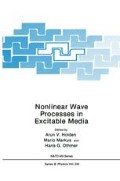Abstract
The shells of many molluscs are decorated with either a relief-like or a pigmentation pattern. These patterns are of great diversity and frequently of great beauty. The formation of these patterns proceeds in most species in a strictly linear manner since new pattern elements are added only along a marginal zone, the growing edge of the shell. The second dimension is a protocol of what happens as a function of time. The shell is, so to speak, a space-time plot. The shells provide a unique situation in that the complete history of a very dynamical process is preserved. We have proposed a model for shell patterning based on reaction-diffusion mechanisms. As shown by computer simulations, this model can account for apparently very different shell patterns if small variations of the parameters or minor changes in the underlying mechanism are assumed [5, 8]. Details of computations can be found in [7]. A model based on similar principles but underlining the possible role of the nervous system has been proposed by Ermentrout et al. [1].
Access this chapter
Tax calculation will be finalised at checkout
Purchases are for personal use only
Preview
Unable to display preview. Download preview PDF.
References
Ermentrout, B., Campbell, J. & Oster, G. (1986). A model for shell patterns based on neural activity. The Veliger 28, 369–338.
Gierer, A. & Meinhardt, H. (1972). A theory of biological pattern formation. Kybernetik 12, 30–39.
Lefever, R. (1968). Dissipative structures in chemical systems. J.Chem.Phys. 49, 4977–4978.
Meinhardt, H. (1982). Models of biological pattern formation. Academic Press: London.
Meinhardt, H. (1984). Models for positional signalling, the threefold subdivision of segments and the pigmentation pattern of molluscs. J. Embryol. exp. Morph. 83 (Supplement)’, 289–311.
Meinhardt, H. & Gierer, A. (1974). Applications of a theory of biological pattern formation based on lateral inhibition. J. Cell Sci. 15, 321–346.
Meinhardt, H. & Klingler, M. (1986). Pattern formation by coupled oscillations: the pigmentation pattern on shells of molluscs. Lecture Notes in Biomath. 71, 184–198.
Meinhardt, H. & Klingler, M. (1987). A model for pattern formation on the shells of molluscs. J. Theor. Biol. 126, 63–69.
Neumann, D. (1958). Morphologische und experimentelle Untersuchungen über die Variabilität der Farbmuster auf der Schale von Theodoxus fluviatilis L. Z. Morph. Ökol. Tiere 48, 349–411.
Prigogine, I. and Lefever, R. (1948). Symmetry breaking instabilities in dissipative systems. II. J. chem. Phys. 48, 1695–1700.
Seilacher, A. (1972). Divaricate patterns in pelecypod shells. Lethaia 5, 325–343.
Seilacher, A. (1973). Fabricational noise in adaptive morphology. Systematic Zool. 22, 451–465.
Turing, A. (1952). The chemical basis of morphogenesis. Phil. Trans. B. 237, 37–72.
Author information
Authors and Affiliations
Editor information
Editors and Affiliations
Rights and permissions
Copyright information
© 1991 Springer Science+Business Media New York
About this chapter
Cite this chapter
Meinhardt, H., Klingler, M. (1991). Pattern Formation on the Shells of Molluscs by Travelling Waves With Unusual Properties. In: Holden, A.V., Markus, M., Othmer, H.G. (eds) Nonlinear Wave Processes in Excitable Media. NATO ASI Series, vol 244. Springer, Boston, MA. https://doi.org/10.1007/978-1-4899-3683-7_22
Download citation
DOI: https://doi.org/10.1007/978-1-4899-3683-7_22
Publisher Name: Springer, Boston, MA
Print ISBN: 978-1-4899-3685-1
Online ISBN: 978-1-4899-3683-7
eBook Packages: Springer Book Archive

